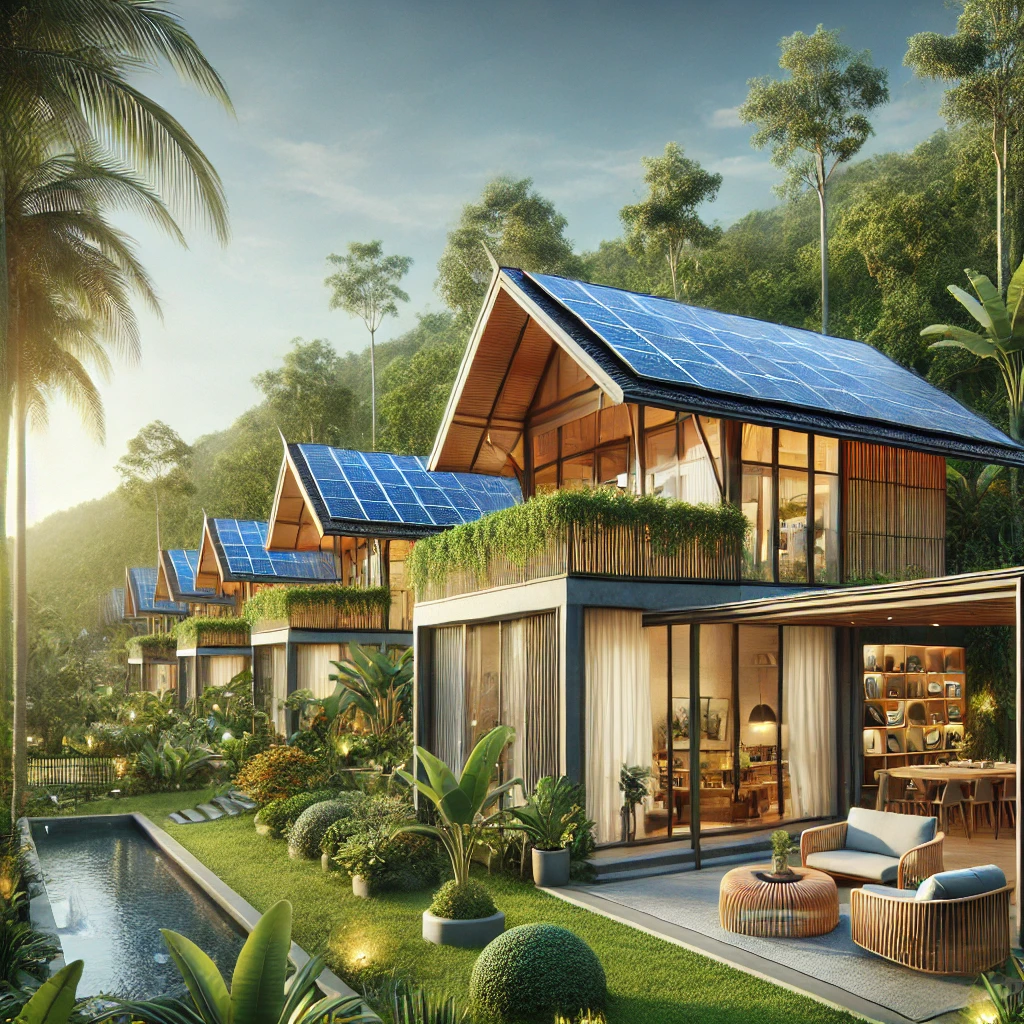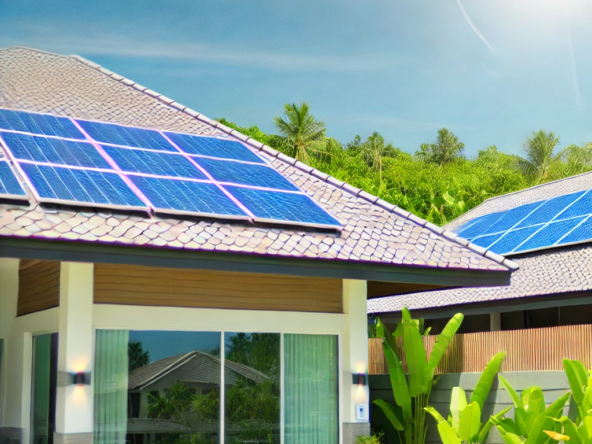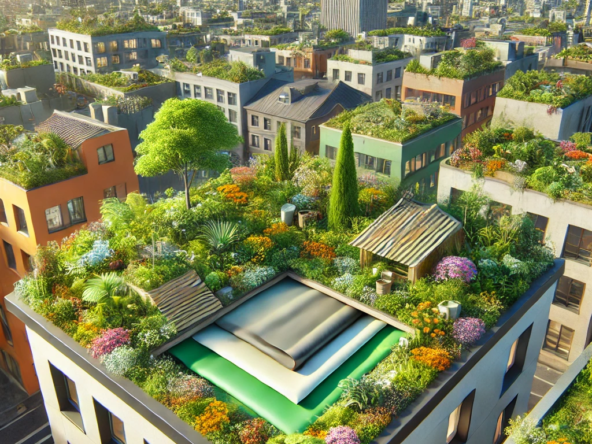Finding Eco-Friendly Upgrades for Thai Properties not only contributes to environmental sustainability but also offers significant financial benefits and increased market appeal. In 2024, Thailand’s commitment to green initiatives has introduced various incentives and opportunities for property owners. This comprehensive guide explores practical steps, localized data, cost-benefit analyses, and the positive impact of eco-friendly enhancements on property value and the environment.
1. Install Solar Panels for Renewable Energy
Thailand’s abundant sunlight makes solar energy a viable option for property owners. By installing solar panels, you can reduce electricity bills and contribute to a cleaner environment.
Localized Data and Examples:
- Energy Consumption: The average household in Thailand consumes approximately 2,781 kWh annually. The Thaiger
- Potential Savings: A standard 5 kW solar system can generate around 7,000 kWh per year, potentially covering your entire electricity needs and allowing surplus energy to be sold back to the grid.
Local Incentives:
The Thai government offers tax incentives for green investments, including tax deductions for solar cell installations. Bangkok Post
Cost-Benefit Analysis:
- Initial Cost: Approximately 150,000 to 200,000 THB for a 5 kW system.
- Long-Term Savings: Potential savings of 20,000 to 30,000 THB annually on electricity bills, leading to a payback period of 5-7 years.
Practical Tips:
- Implementation: Consult certified solar installers to assess your property’s suitability and obtain necessary permits.
- Maintenance: Regularly clean panels to remove dust and debris, ensuring optimal efficiency.
2. Upgrade to Energy-Efficient Appliances and Lighting
Replacing outdated appliances and lighting with energy-efficient alternatives reduces energy consumption and lowers utility bills.
Localized Data:
- Energy Savings: Switching to LED lighting can reduce energy usage by up to 80% compared to incandescent bulbs.
Cost-Benefit Analysis:
- Initial Cost: LED bulbs cost around 100 THB each.
- Long-Term Savings: Savings of approximately 500 THB per bulb over its lifespan due to reduced energy consumption and longer durability.
Practical Tips:
- Implementation: Prioritize replacing high-use fixtures and appliances with energy-efficient models.
- Maintenance: Regularly clean and service appliances to maintain efficiency.
3. Install Water-Saving Fixtures
Water conservation is crucial in Thailand, especially during dry seasons. Installing water-saving fixtures helps reduce water usage and costs.
Localized Data:
- Water Consumption: The average Thai household uses about 200 liters of water per person per day.
Cost-Benefit Analysis:
- Initial Cost: Low-flow showerheads and faucets range from 500 to 1,000 THB.
- Long-Term Savings: Potential reduction in water bills by 20-30%, leading to savings of 1,000 to 2,000 THB annually.
Practical Tips:
- Implementation: Install low-flow fixtures in bathrooms and kitchens.
- Maintenance: Regularly check for leaks and clean aerators to ensure optimal performance.
4. Utilize Sustainable Building Materials
Incorporating eco-friendly materials during renovations or construction reduces environmental impact and enhances property appeal.
Local Examples:
- Bamboo Flooring: Bamboo is a fast-growing, renewable resource available locally in Thailand.
- Recycled Materials: Using reclaimed wood and recycled metal reduces waste and adds unique character to your property.
Cost-Benefit Analysis:
- Initial Cost: Sustainable materials may have a higher upfront cost but offer durability and aesthetic appeal.
- Long-Term Savings: Reduced maintenance costs and potential for higher property value due to eco-friendly features.
Practical Tips:
- Implementation: Source materials from certified suppliers and ensure proper installation.
- Maintenance: Follow manufacturer guidelines for care to prolong the lifespan of materials.
5. Enhance Natural Ventilation and Insulation
Improving ventilation and insulation reduces reliance on air conditioning, leading to energy savings.
Localized Data:
- Climate Considerations: Thailand’s tropical climate makes natural ventilation essential for comfort.
Cost-Benefit Analysis:
- Initial Cost: Installing ceiling fans and insulating materials can range from 10,000 to 50,000 THB.
- Long-Term Savings: Potential reduction in energy bills by 10-20%, leading to savings of 2,000 to 5,000 THB annually.
Practical Tips:
- Implementation: Install ceiling fans, use light-colored roofing materials, and ensure proper insulation in walls and roofs.
- Maintenance: Regularly clean fans and inspect insulation for damage.
6. Incorporate Eco-Friendly Landscaping
Sustainable landscaping enhances property aesthetics and supports local ecosystems.
Local Examples:
- Native Plants: Utilize Thai native species like Plumeria and Hibiscus, which require less water and maintenance.
Cost-Benefit Analysis:
- Initial Cost: Native plants and sustainable landscaping features can range from 5,000 to 20,000 THB.
- Long-Term Savings: Reduced water and maintenance costs, with potential savings of 1,000 to 3,000 THB annually.
Practical Tips:
- Implementation: Design gardens with native plants, install rainwater harvesting systems, and use organic fertilizers.
- Maintenance: Regularly prune plants and monitor irrigation systems for efficiency.
7. Invest in Smart Home Technology
Smart home devices offer efficient energy management and appeal to eco-conscious buyers and renters by automating energy use in a sustainable way. These systems allow you to remotely monitor energy and water consumption, optimizing usage and reducing waste.
Cost-Benefit Analysis:
- Initial Cost: Smart thermostats, automated lighting, and power strips can range from 5,000 to 15,000 THB.
- Long-Term Savings: These devices can reduce energy consumption by 10-15%, leading to annual savings of approximately 2,000 to 5,000 THB.
Practical Tips:
- Step-by-Step Implementation: Start with a smart thermostat to control cooling costs, followed by motion sensor lighting for areas with variable occupancy.
- Maintenance: Regularly update software to ensure optimal performance and periodically test devices to make sure they’re working efficiently.
8. Consider Greywater Recycling Systems
Greywater recycling reuses water from sinks, showers, and laundry for irrigation and toilet flushing, reducing overall water consumption. This system is ideal for eco-friendly properties in Thailand, where water conservation is especially important during the dry season.
Cost-Benefit Analysis:
- Initial Cost: Installation typically ranges from 15,000 to 30,000 THB, depending on the system’s complexity.
- Long-Term Savings: You could save up to 30% on water bills annually, potentially translating to annual savings of 1,500 to 3,000 THB.
Practical Tips:
- Step-by-Step Implementation: Consult with local installers to assess your plumbing system’s compatibility with greywater systems.
- Maintenance: Regularly clean filters and check for any leaks to maintain system efficiency.
9. Eco-Friendly Certifications and Local Organizations
Achieving eco-certifications enhances the value of your property by aligning it with recognized sustainable standards. In Thailand, these certifications add credibility and appeal to an increasingly eco-conscious market.
Relevant Certifications:
- LEED Certification: An internationally recognized certification for energy and resource-efficient buildings.
- EDGE Certification: Targeted at tropical climates, EDGE is popular in Southeast Asia for focusing on efficient energy, water, and material usage.
Local Sustainable Organizations:
- Thai Green Building Institute (TGBI): Offers guidance on green building standards in Thailand.
- Green Leaf Foundation: Promotes eco-friendly practices within Thailand’s hospitality and real estate sectors.
Practical Tips:
- Engage with Local Groups: Partnering with organizations like TGBI or consulting with certified green builders can help streamline the certification process.
- Maintain Certification: Many certifications require annual audits, so keep records of energy and water consumption for easy reporting.
10. Appeal to Eco-Conscious Tourists with Green Amenities
Eco-tourism is on the rise, with travelers increasingly favoring sustainable accommodation. By integrating eco-friendly features into your property, you can attract eco-conscious guests, boost rental rates, and improve occupancy.
Popular Eco-Friendly Amenities:
- Reusable Amenities: Provide guests with reusable water bottles and bamboo toiletries to reduce waste.
- On-Site Composting: Composting stations add an interactive element for guests who value sustainability.
- Rainwater Irrigation: Use rainwater for garden watering, which visitors can observe and appreciate as a unique eco-feature.
Tourist Appeal:
- Market Differentiation: Eco-friendly amenities set your property apart, especially in tourist-heavy areas like Phuket and Chiang Mai.
- Higher Rental Rates: Guests are often willing to pay more for sustainable properties, which can lead to higher revenue from rentals.
11. Long-Term Environmental and Market Impact
Eco-friendly upgrades do more than cut costs—they contribute to a sustainable future for Thailand’s natural resources. Properties with green features are positioned for long-term market resilience and appeal, attracting buyers, renters, and guests who prioritize sustainability.
Environmental Benefits:
- Reduction in Carbon Footprint: Energy-efficient upgrades and renewable energy sources, such as solar panels, lower the carbon emissions associated with property use.
- Water Conservation: With water-saving fixtures and greywater recycling, eco-friendly properties can help alleviate Thailand’s water shortages, particularly during the dry season.
- Support for Local Ecosystems: Native plants and sustainable landscaping create habitats for wildlife and enhance biodiversity.
Positive Impact on Thai Ecosystems:
- Preservation of Natural Resources: By reducing water and energy consumption, eco-friendly properties lessen the environmental impact on Thailand’s ecosystems, supporting long-term tourism sustainability.
- Reduction of Urban Heat Islands: Green roofs, tree planting, and reflective roofing materials help reduce the heat generated by urban areas, creating a cooler environment for local communities.
Conclusion: The Long-Term Investment Appeal of Eco-Friendly Thai Properties
Investing in eco-friendly upgrades for your Thai property not only enhances sustainability but also boosts its market value, long-term appeal, and financial performance. Properties with green features attract a growing pool of eco-conscious buyers, renters, and tourists who are willing to pay a premium for sustainable living. Additionally, the energy and water savings from these upgrades deliver financial benefits over time, making your property more economical to maintain and attractive to future owners.
As eco-tourism continues to grow and the Thai government incentivizes green practices, eco-friendly upgrades differentiate your property in a competitive market, making it more desirable and resilient. By implementing sustainable solutions, you’re not only contributing to Thailand’s environmental health but also ensuring your property remains a high-value asset in the country’s evolving real estate landscape.
In summary, eco-friendly properties in Thailand offer a strong return on investment while supporting a sustainable future. Embracing green upgrades is a wise choice for property owners looking to make a positive impact while maximizing long-term market potential.



